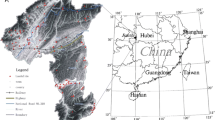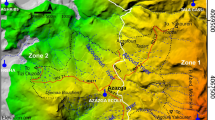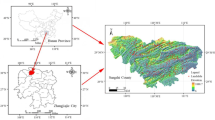Abstract
Catastrophic landslides and debris slides triggered by intense storms such as Typhoon Morakot (2009) occurred more frequently in recent years, and caused many casualties and economic loss in Taiwan. For the purpose of reducing damage resulted from geological hazards, this study collected landslide inventory which contains the information of occurrence such as time, location, size of failure, mean rainfall intensity, and rainfall duration with new measurement techniques. The precipitation data, satellite image, geology, terrain unit, topography mapping, and field survey are then combined to GIS for extracting the triggering factors of landslide. Furthermore, the multi period event-based landslide inventory and corresponding data are performed to establish the shallow landslide prediction model by logistic regression method and critical rainfall threshold for landslide early-warning system also developed. The landslide susceptibility model, landslide hazard scenario technique, and early-warning system were developed based on the systematical event-based landslide inventory. Validation with more than 200 cases show that the accuracy of the model is about 75–85% and the result could be applied to regional land-use planning, construction site selection, disaster prevention, and mitigation for civil infrastructure.
Access provided by Autonomous University of Puebla. Download conference paper PDF
Similar content being viewed by others
Keywords
1 Introduction
In last decade, Taiwan suffered more than 10 fatal typhoons and heavy rainfalls, and as a result, it brought forth wide-spreading landslide disasters and casualties. Recently, the Central Geology Survey (CGS) of the Ministry of Economic Affairs has been seriously concerned by rainfall-induced shallow landslide hazards (or called debris sliding), and engaged in investigation and research regarding landslide causes. The study attempted to develop the countermeasures to mitigate landslide hazards and helps warning residents around susceptible regions before the occurrence of landslide. For investigating the effect of geological condition, the work also divides Taiwan into different geological zones such as metamorphic rocks (non-foliated), metamorphic rocks (slate), volcanic rocks, sandstone, shale, alternations of S.S. & Sh, mudstone, conglomerate, gravel and so on to explore the landslide characteristics. This study chose more than 498 landslide sites including the actual occurrence time. By analyzing precipitation data of landslides and statistical susceptibilities (initial landslide potential), an automatic landslide susceptibility model was constructed subsequently. Finally, the automated susceptibility analysis and real time display system were established for early warning purposes.
2 Landslide Inventory and Landslide Susceptibility Map
The landslide inventories in Taiwan have been systematically established since 2007. The landslide spatial distributions are confirmed by comparing satellite images (i.e. SPOT4, SPOT5) before and after the disaster, so that the event-based landslides inventory can be derived. As a consequence of this advantage in multi-event landslide inventories, a workflow for generating landslide susceptibility map is currently being proceeded by using probability methods as much geological and hydrological data in the field are insufficient for practical purpose (Guzzetti et al. 2005, 2008; Galli and Guzzetti 2007; Lee et al. 2008; Lee 2009; Central Geological Survey 2010; Ghosh et al. 2012; Lo et al. 2012). The conceptual workflow of landslide susceptibility analysis adopted is shown as Fig. 279.1.
Landslide Susceptibility (LS) is defined as the likelihood of landslides on the basis of local terrain and hydrological conditions. LS zonation refers to the division of the land into homogeneous areas or domains according to the degree of actual or potential hazard (Varnes 1984). Landslide susceptibility analysis (LSA) is the most commonly used statistical approach in which landslide inventories and causative factors are utilized to build a susceptibility model for predicting possible landslides. The model is then used to establish LS maps and distinguish the levels of LS for the study region. This study adopts the logistic regression method of multivariate analysis. The formula is described as follows:
where, P i is the landslide susceptibility index (LSI) at the ith element while k landslide susceptibility factors such as slope gradient (x 1i , x 2i ,…, x ki ) are given. Ordinarily, the higher LSI indicates the greater landslide potential, whereas, the lesser one the low landslide potential for a specific terrain element.
Landslide susceptibility map described in this study is generated by using terrain unit as the individual analysis element. Terrain unit is a slope surface area with similar topographical features and geological characteristics, dividing mainly by river valley and mountain ridge (Xie et al. 2004) and is more useful in slope hazard management than grid unit (Fig. 279.2).
Grid and slope units at the mountainous region: a grid unit; b terrain unit (Xie et al. 2004)
In terms of model verification, this work adopts classification error matrix to examine the stability and accuracy of landslide susceptibility model. The susceptibility of each terrain unit is graded into high, moderate, and low susceptibility to build landslide susceptibility map. The new landslide susceptibility map in terrain unit type and the grid mesh type are made.
3 Automatic Landslide Susceptibility Model and the Real Time Landslide Early Warning System
For the purpose of disaster prevention, an automatic landslide susceptibility model was developed in this research. Once the rainfall increases continuously, the managing authority can adjust the emergency assessment depending on the susceptibility value of each terrain unit calculated from real time automatic landslide susceptibility model. Even though in the sunny day, the landslide susceptibility of each terrain unit is not zero due to the conditions of geology (e.g. rock strength, faults, and folds), topography (e.g. gradient) and hydrology (e.g. ground water). According to this concept, the automatic landslide susceptibility (P) consists of two parts including the static susceptibility (P 0) and the rainfall increased susceptibility (WR) as follows:
P is the sum of P 0 and WR, the higher value of P indicates the terrain unit is more unstable; P 0 is the landslide susceptibility without rainfall effect and can be derived from Eq. (279.1); W is the weighting factor of each geological zone relative to the rainfall effect which can be calculated from the collected cases by statistic method; R represents the accumulated rainfall. This model sets P = 1 as the critical states of slope stability, the slope is stable when P < 1 whereas P > 1 depicts the slope to be situated in the failure state.
After the model was established, more than 200 cases are used for validation under the condition of P = 1 (critical state). One of the cases is shown in Fig. 279.3a. As in the P-Duration diagram (Fig. 279.3b, upper part), the P 0 of this terrain unit is about 0.50 and the W of this geological zone is 0.000962, the value of P can be calculated from Eq. (279.2) with the increasing of accumulated rainfall (R, Fig. 279.3b, lower part). When R reaches 520 mm, the value of P is above 1, indicating that the slope is on the critical state and finally the slope collapses when R is 594 mm whereas the value of P is approximately 1.07. Through this process of validation, the accuracy in different geological zones are approximately 75–85%, showing a good agreement between field survey and model prediction.
For practical application, this model is embedded within a Web-GIS system (RiLEWIS). The real time grid-based rainfall data (QPESUMS) from Central Weather Bureau is also connected with this system. Landslide susceptibility of each terrain unit will calculate automatically and updates immediately as the accumulated rainfall varies (shown as Fig. 279.4). Four different color (i.e. green, yellow, orange, and red) indicating the distinct landslide hazards are assigned. The first three colors represent low (green), moderate (yellow), and moderate-high level (orange) landslide hazards (P < 1, Fig. 279.5). Red color (P > 1) suggests a failure state for a specific terrain unit under a great amount of rainfall condition.
4 Conclusion
Rainfall-induced shallow debris sliding is a more common slope hazard when compared to rock fall and rock sliding in mountainous regions. This paper proposed a new idea and model for the susceptibility assessment of rainfall-induced landslide in Taiwan. Through the validation of more than 200 cases shows that the accuracy of this model is about 75–85% in different geological zones, which indicates that the model can be used for setting up rainfall thresholds. A preliminarily early warning system has also been established in this work for providing early warning and reducing the losses of human life and properties.
References
Central Geological Survey (CGS, Taiwan) (2010) Landslide susceptibility assessment of slopes around Urban Area (4/4). Project report prepared by Sinotech Engineering Consultants, Inc. (in Chinese)
Lo CM, Huang WK, Lin ML, Dong JJ, Chang, KT, Chi SY (2012) Effects of geological characteristics on the kinematics of Hungtsaiping landslide during earthquake events. International symposium on earthquake-induced landslide, 7–9 Nov, Kiryu, Japan (Congress)
Galli M, Guzzetti F (2007) Landslide vulnerability criteria: a case study from Umbria, Central Italy. Environ Manage 40:649–664
Ghosh S, van Weste CJ, Carranza EJM, Jetten VG, Cardinali M, Rossi M, Guzzetti F (2012) Generating event-based landslide maps in a data-scarce Himalayan environment for estimating temporal and magnitude probabilities. Eng Geol 128:49–62
Guzzetti F, Reichenbach P, Cardinali M, Galli M, Ardizzone F (2005) Probabilistic landslide hazard assessment at the basin scale. Geomorphology 72:272–299
Guzzetti F, Ardizzone F, Cardinali M, Galli M, Reichenbach P, Rossi M (2008) Distribution of landslides in the Upper Tiber River basin, central Italy. Geomorphology 96:105–122
Lee CT (2009) Review and prospect on landslide and debris flow hazard analysis. J Taiwan Soc Public Works 15(1):1–29 (in Chinese)
Lee CT, Huang CC, Lee JF, Pan KL, Lin ML, Dong JJ (2008) Statistical approach to earthquake-induced landslide susceptibility. Eng Geol 100:43–58
Varnes DJ (1984) Landslide hazard zonation—a review of principles and practice. Nat Hazards 3:63
Xie M, Esaki T, Zhou G (2004) GIS-based probabilistic mapping of landslide hazard using a three-dimensional deterministic model. Nat Hazards 33:265–282
Author information
Authors and Affiliations
Corresponding author
Editor information
Editors and Affiliations
Rights and permissions
Copyright information
© 2015 Springer International Publishing Switzerland
About this paper
Cite this paper
Wei, LW., Lee, CF., Huang, CM., Huang, WK., Lin, HH., Chi, CC. (2015). A Prelimilary Study of the Rainfall Threshold and Early Warning System for Landslide in Taiwan. In: Lollino, G., et al. Engineering Geology for Society and Territory - Volume 2. Springer, Cham. https://doi.org/10.1007/978-3-319-09057-3_279
Download citation
DOI: https://doi.org/10.1007/978-3-319-09057-3_279
Published:
Publisher Name: Springer, Cham
Print ISBN: 978-3-319-09056-6
Online ISBN: 978-3-319-09057-3
eBook Packages: Earth and Environmental ScienceEarth and Environmental Science (R0)









